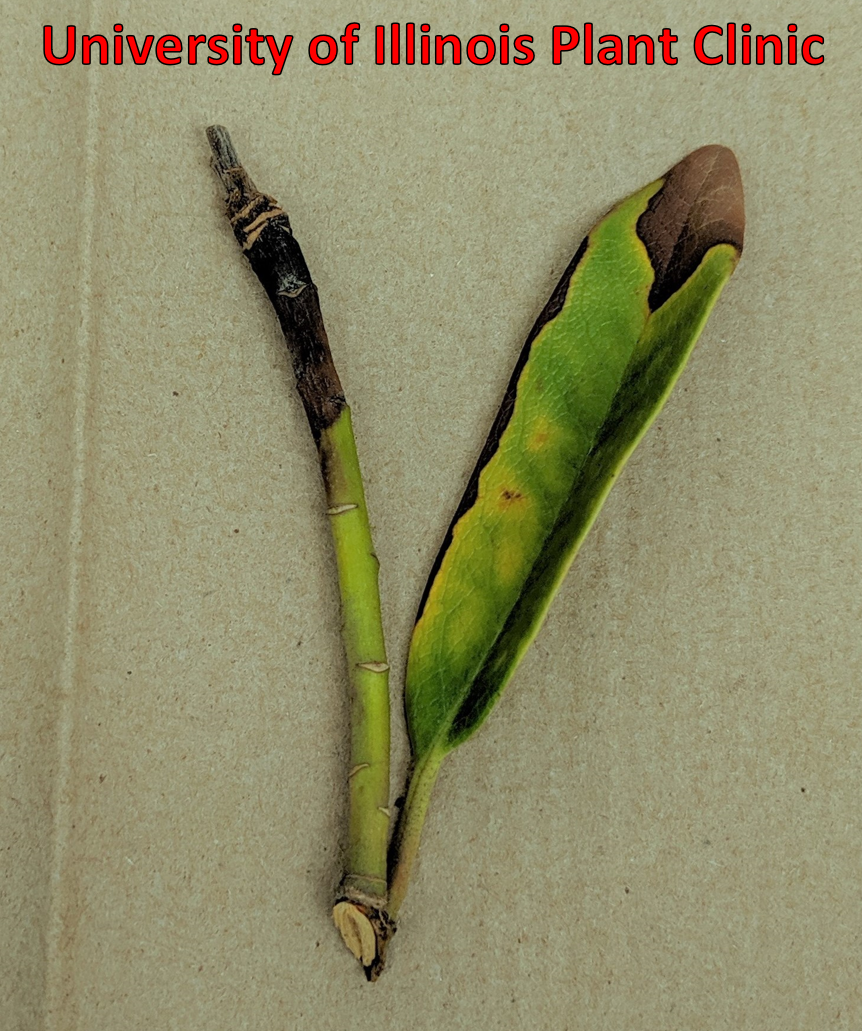Issue 7, July 15, 2019
Ramorum Blight Confirmed on Samples Taken from Illinois Garden Centers
The Illinois Department of Agriculture published a press release July 2 announcing that Phytophthora ramorum, causal agent of Ramorum blight and Sudden Oak Death, had been confirmed on samples taken from garden centers in the state.: https://www2.illinois.gov/Pages/news-item.aspx?ReleaseID=20290
Phytophthora ramorum is a federally regulated plant pathogen which has devastated native plants and forests in California and Oregon over the past several decades. The pathogen causes two groups of symptoms, often referred to as two separate diseases: Ramorum blight and Sudden Oak Death. P. ramorum can infect a wide range of hosts, including many popular ornamentals (rhododendron, azalea, lilac, viburnum, and more), as well as oak trees. Ramorum blight causes leaf discoloration and branch dieback on the ornamental hosts, while Sudden Oak Death causes rapid wilting, decline, and death of oak and tanoak trees. Ramorum blight usually does not kill infected plants, but symptoms will continue to reoccur.

In late May 2019, a routine survey in Indiana confirmed the presence of P. ramorum on rhododendrons received from Oklahoma. The original source of the plants were nurseries in Washington and British Columbia. Shipping records revealed that plants from the same nurseries were routed through Oklahoma to garden centers in 18 Midwest states, including Illinois. Illinois Department of Agriculture and United States Department of Agriculture field staff inspected stores which had received plants from the same shipment and collected samples from symptomatic plants. Those samples were tested at laboratories including the University of Illinois Extension Plant Clinic, Michigan State, Cornell, Kansas State, and USDA labs. P. ramorum was confirmed on plant material in stores across the state. So far, one other state which received samples from the same shipment has confirmed P. ramorum (Kansas) bringing the total number of affected states to 3.
A similar situation occurred in the early 2000s. Nursery plants in 19 southwestern, southeastern, and northeastern states were confirmed with P. ramorum. Those plants were destroyed, and there is no evidence that the pathogen became established in the natural environment in any of the affected states. Risk maps based on epidemiological models indicate that most of Illinois is considered at low risk to this pathogen. The greatest threat would be in southern Illinois in the natural forested areas, and along the southern banks of the Mississippi.
While there are products labeled for use on oak trees against Sudden Oak Death, we currently are not recommending treatments since the pathogen has yet to be identified in the environment or on oak trees.
The public is being asked to be on the lookout for plants which could potentially be infected with P. ramorum.
Because P. ramorum is not known to have been found in Illinois before this year, plants purchased prior to 2019 are unlikely to be infected. While P. ramorum has a wide host range, so far it has only been confirmed on rhododendron and lilac hosts shipped to the Midwest. Symptoms of P. ramorum can appear similar to disease, insect, and environmental damage, including bacterial blight on lilac and winter injury on rhododendrons.
Questions to answer if you are concerned about a specific plant:
- Was the plant purchased in 2019?
- Is the plant a lilac, rhododendron, or azalea?
- Is the plant displaying any of the following symptoms:
- Dark brown spots, blotches, or tip dieback on leaves?
- Dark brown discoloration along the leaf margins?
- Dark brown discoloration of the branches, usually starting at the tip of the branch?
If the answers to all the above questions are YES, please contact the Illinois Department of Agriculture (IDOA) at (815) 787-5476. Do NOT submit samples to local Extension offices, arboretums, parks, or to the University of Illinois Extension Plant Clinic if you suspect the plant is infected with P. ramorum without first contacting the IDOA. Do NOT destroy the suspected plant without the approval of the IDOA. Because the pathogen can spread through irrigation water, we recommend either not irrigating possible infected plants, or watering at the base of the plants (try to avoid wetting the leaves or creating irrigation runoff). Sanitize any tools or equipment that may have come into contact with suspect plants (10% bleach or 70% ethanol solutions are appropriate for most situations).
The University of Illinois Extension Plant Clinic published an Alert that can be downloaded here: https://uofi.box.com/v/Pramorumalert
Author:
Diane Plewa